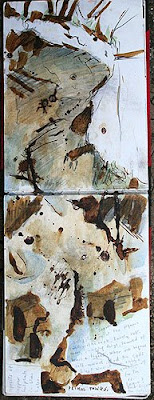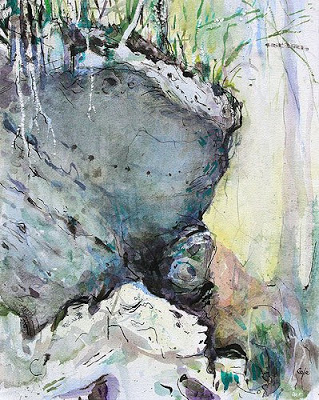
2001 – 2008
Watercolour & Ink.
30 x 40cm (15 x 11 inches).
© The Artist.

2001
pen & ink
doublespread A5 sketchbook
© The Artist.
a prehistoric shelter…
John Ruskin
John Ruskin (1819–1900) was another artist who was mad about rocks. He was a lake-lander (the Lake District in the UK. I used to walk & watercolour there whilst at Newcastle University :-). He also an in-depth student of geology & amassed a comprehensive collection of rocks & minerals.
If only the Geologists would let me alone, I could do very well, but those dreadful Hammers! I hear the clink of them at the end of every cadence of Bible verses and on the other side, these unhappy, blinking Puseyisms; men trying to do right and losing their very humanity – Ruskin
He paid very great attention to detail, lovingly, as if each ripple & blow hole was significative of ‘The Hand of God’. So much so that he was criticised by an Parisienne asethete for ‘having the eyes of a bird’ (ie he saw only details & not wholes). But map making & exactitude, for me, is an important element of respecting ‘the spirit of the place’. Even the wildest flights of imagination are more convincingly portrayed in painting when yoked with a real & close observation of ‘the facts’.
Look at this great pen & ink from the Ashmolean, Oxford. I’ve not seen this one ‘in the flesh’ (wish that Wiki would note it’s dimensions! decontextualised internet…). A monochrome of great power. At a guess I would say at least two sittings, maybe of about tree hours each. Maybe more. One of the many things I adamire about Ruskin’s painting is that you rarely feel rushed. He would just leave the piece unfinished, incomplete rather than rush or ‘fill-in’.
Study of Gneiss Rock, Glenfinlas, 1853
Pen and ink and wash with Chinese ink on paper
Ashmolean Museum, Oxford, England.
Photo credit : wiki commons


